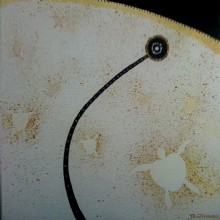This is a free exhibition showing at the Flinders University City Gallery at the State Library. It focuses on Australia’s unique relationship with the land and notions of an Australian identity. Eleven different Australian artists exhibited select works, with historical, contemporary, indigenous and non-indigenous significance. It features some of Australia’s most prominent artists, such as Lorraine Connelly-Northey, John Davis, Russell Drysdale, Rosalie Gascoigne, Emily Kame Kngwarreye, Dorothy Napangardi, Sidney Nolan, John Olsen, Lin Onus, Rover Thomas and Fred Williams. Below, I have discussed a couple of artists that really stood out to me.
Lin Onus
Lin Onus’ painting ‘Ginger and my third wife approached the roundabout’ was a really interesting and intriguing piece of artwork. I thought the title was really strange, yet related to the painting well. The work combined Aboriginal Rrark patterning with a more contemporary western-realist style. The overall effect resulted in a somewhat abstract feel, yet all of the elements seemed to fit well together. The background appeared realistic and the shadows under the rays help create depth.
‘Ginger and my third wife approached the roundabout’ Lin Onus
Rosalie Gascoigne
The artworks by Gascoigne grabbed my attention quickly as I found they were different and quite unique. The installation displayed on the floor called ‘Inland Sea’ was made up of a number of corrugated iron pieces she had collected. They were cut into squares and raised up by circular wire stands to create a kind of loose grid arrangement. The pale greys and whites of some of the sheets imply clouds, while the green and red sheets suggest the landscapes hilly plains. By lifting the pieces up at differing heights they reflect the rise and fall of the landscape and the wind rippling the water like gentle waves.
Rosalie Gascoigne ‘Inland sea’
Weathered painted corrugated iron, wire
Emily Kame Kngwarreye
I was immediately attracted to Emily’s work as her paintings use rich vibrant colours that grab your attention. She worked in many different styles but her energetic gestures always reflected an aspect of her Dreamings and home country. The bold and expressive lines (yam tracks) that interconnect and overlay in her piece Kame Colour II reflect the endless landscape of Australia. When I stood infront of this large painting, I got a feeling of great complexity and the warm colours used reminded me of the hot climate in central Australia.
Emily Kame Kngwarreye - Kame Colour II

































